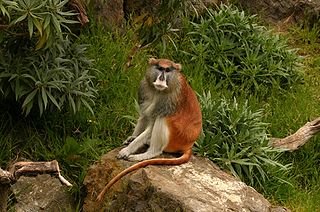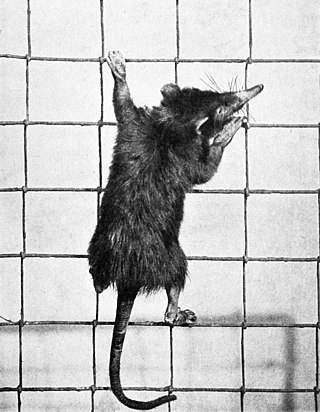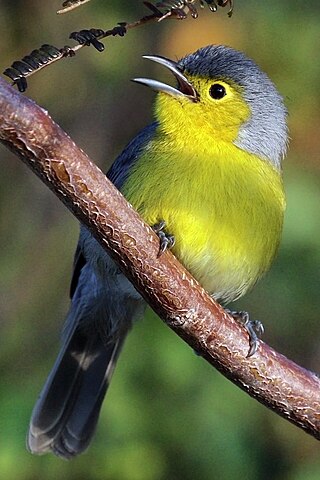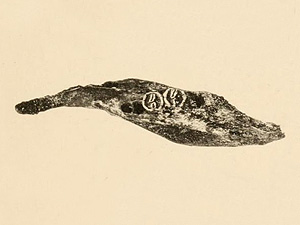
Erythrocebus is a genus of Old World monkey. All three species in this genus are found in Africa, and are known as patas monkeys. While previously considered a monotypic genus containing just E. patas, a 2017 review argued that, based on morphological evidence and heavy geographic separation between taxa, E. patas should be split back into distinct species as recognised in the 19th century.

The Cuban solenodon or almiquí is a small, furry, shrew-like mammal endemic to mountainous forests on Cuba. It is the only species in the genus Atopogale. An elusive animal, it lives in burrows and is only active at night when it uses its unusual toxic saliva to feed on insects. The solenodons, native to the Caribbean, are one of only a few mammals that are venomous.

The snowcocks or snowfowl are a group of bird species in the genus Tetraogallus of the pheasant family, Phasianidae. They are ground-nesting birds that breed in the mountain ranges of southern Eurasia from the Caucasus to the Himalayas and western China. Some of the species have been introduced into the United States. Snowcocks feed mainly on plant material.

The Oriente warbler is one of two species of bird in the Cuban warbler family Teretistridae. It is endemic to central and eastern Cuba.

The Oriente cave rat is an extinct species of rodent in the family Echimyidae. It was endemic to Cuba. Its natural habitat was subtropical or tropical moist lowland forests. It is known from recent fossil records, and may have become extinct with the introduction of other rats.
Piper supernum is a species of plant in the family Piperaceae. It is endemic to Ecuador.
Coccothrinax pauciramosa, the yuraguana or yuraguana vestida, is a palm which is endemic to Cuba. Like other members of the genus, C. pauciramosa is a fan palm. Trees are single-stemmed, between 2 and 5 metres tall with stems 4 to 8 centimetres in diameter. The fruit is purple-black, 0.7–1.2 cm in diameter.

The Aru flying fox is a Critically Endangered species of megabat found in the Aru Islands in Indonesia. It was described by Wilhelm Peters in 1867. It was formerly considered a subspecies of the black-bearded flying fox. The species is poorly known, and has not been encountered since the 19th century. It is classified as critically endangered by the IUCN and is listed on CITES appendix II.
Garrya fadyenii is a species of flowering shrub known by the common name Fadyen's silktassel. It is native to the West Indies, specifically Jamaica, Hispaniola, and the former Cuban provinces of Oriente and Santa Clara. It grows in rocky areas of mountainous tropical rainforests.
Arrhyton is a genus of New World snakes, commonly known as island racers or racerlets, in the family Colubridae. The genus contains 9 described species.

Manilkara jaimiqui, commonly known as wild dilly, is a woody plant in the family Sapotaceae. It is native to tropical regions of North America, where it is found in the West Indies and south Florida. Its natural habitat is areas of coastal hammocks and pine rocklands.
Ramsden's least gecko is a species of lizard in the family Sphaerodactylidae. The species is endemic to Cuba.
Arrhyton ainictum, the Las Tunas racerlet or Cuban Island racer, is a species of snake in the family Colubridae. It is found in Cuba.
Arrhyton dolichura, the Havana racerlet or Habana Island racer , is a species of snake in the family Colubridae. It is found in Cuba.
Arrhyton procerum, the Zapata long-tailed racerlet or Zapata long-tailed groundsnake is a species of snake in the family Colubridae. It is found in Cuba.
Arrhyton redimitum, the Oriente brown-capped racerlet, is a species of snake in the family Colubridae. It is found in Cuba.
Arrhyton taeniatum, the broad-striped racerlet or Günther's Island racer, is a species of snake in the family Colubridae. It is found in Cuba.
Arrhyton tanyplectum, the Guaniguanico racerlet or San Vincente Island racer, is a species of snake in the family Colubridae. It is found in Cuba.
Arrhyton vittatum, the Cuban short-tailed racerlet or common island racer, is a species of snake in the family Colubridae. It is found in Cuba.







